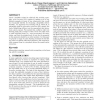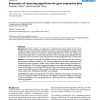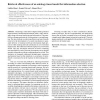184 search results - page 28 / 37 » Learning Expressive Models for Word Sense Disambiguation |
PRIMA
2009
Springer
14 years 2 months ago
2009
Springer
In recent years, the topic of emotion reading has increasingly received attention from researchers in Cognitive Science and Artificial Intelligence. To study this phenomenon, in th...
IIR
2010
13 years 9 months ago
2010
Given a classifier trained on relatively few training examples, active learning (AL) consists in ranking a set of unlabeled examples in terms of how informative they would be, if ...
BMCBI
2006
13 years 7 months ago
2006
Background: Cluster analysis is an integral part of high dimensional data analysis. In the context of large scale gene expression data, a filtered set of genes are grouped togethe...
VLDB
2004
ACM
14 years 7 months ago
2004
ACM
Technology in the field of digital media generates huge amounts of nontextual information, audio, video, and images, along with more familiar textual information. The potential for...
ISWC
2002
IEEE
14 years 17 days ago
2002
IEEE
The Parasitic Humanoid (PH) is a wearable robot for modeling nonverbal human behavior. This anthropomorphic robot senses the behavior of the wearer and has the internal models to ...



